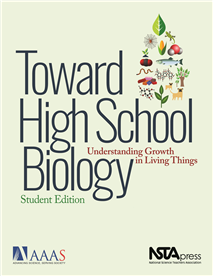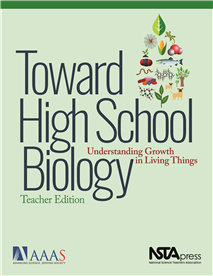Toward High School Biology: A New Curriculum for Your Middle School Students
By Carole Hayward
Posted on 2017-09-29
Would you like to challenge your middle school students to explain a range of phenomena—from how nylon thread can form from two clear, colorless liquids to how a snake that eats only eggs can make body structures that don’t look anything like an egg? Would your students enjoy building molecular models with Legos to understand how an herbicide prevents weeds from growing? If so, then Toward High School Biology: Understanding Growth in Living Things by AAAS/Project 2061 is the curriculum for you.
Developed by a team of scientists and science educators and funded by a U.S. Department of Education Institute of Education Sciences grant, Toward High School Biology was field tested extensively. Results show that students who used the unit had significant learning gains compared with students who used other materials. The unit’s 19 lessons support the Next Generation Science Standards and integrate all three dimensions of science learning, with a strong emphasis on supporting students in developing evidence-based explanations. The goal of the unit is to help middle school students overcome many common conceptual difficulties and provide the foundation in biochemistry that students will need for high school biology and beyond.
Jo Ellen Roseman, director of Project 2061 (a long-term initiative of the American Association for the Advancement of Science [AAAS]) explains, “High school biology is fairly molecular. There has to be something in middle school to give [students] the background they need for thinking about what is happening.”
 In the Student Edition, each chapter of the Toward High School Biology unit consists of carefully sequenced lessons and activities designed to draw upon students’ prior knowledge and experiences relevant to classroom activities; support students as they investigate and make sense of phenomena and models; guide students in developing, analyzing, and critiquing explanations (e.g., of a hypothetical student, of their peers, and of those of the scientific community) in light of their experiences; provide opportunities for students to apply or extend science ideas and practices to new phenomena; and help students synthesize their ideas and reflect on changes in their thinking.
In the Student Edition, each chapter of the Toward High School Biology unit consists of carefully sequenced lessons and activities designed to draw upon students’ prior knowledge and experiences relevant to classroom activities; support students as they investigate and make sense of phenomena and models; guide students in developing, analyzing, and critiquing explanations (e.g., of a hypothetical student, of their peers, and of those of the scientific community) in light of their experiences; provide opportunities for students to apply or extend science ideas and practices to new phenomena; and help students synthesize their ideas and reflect on changes in their thinking.
 The Teacher Edition includes everything in the Student Edition, but it also is designed to provide easy access to essential background information and support needed for using the Toward High School Biology unit effectively in the classroom. Additional teacher support materials (e.g., brief video demonstrations, color images from the unit, and tutorials) are provided online. The Teacher Edition and the supplementary materials aim to provide a “big picture” sense of the unit and its goals as well as the specific information and guidance needed to teach each lesson and carry out each activity.
The Teacher Edition includes everything in the Student Edition, but it also is designed to provide easy access to essential background information and support needed for using the Toward High School Biology unit effectively in the classroom. Additional teacher support materials (e.g., brief video demonstrations, color images from the unit, and tutorials) are provided online. The Teacher Edition and the supplementary materials aim to provide a “big picture” sense of the unit and its goals as well as the specific information and guidance needed to teach each lesson and carry out each activity.
Learning theory and research-based evidence guided AAAS/Project 2061’s development of Toward High School Biology. The unit reflects the team’s understanding that students’ science conceptions develop from (a) having a wide range of experiences with the natural world that can be explained by a coherent set of ideas and (b) having an opportunity to interpret and make sense of experiences in terms of those ideas.
Moreover, student understanding of the learning goals increases when students (a) observe phenomena and representations that are explicitly targeted to the learning goals and are selected to address common student difficulties and (b) are actively engaged in interpreting the phenomena and representations in light of the learning goals and their own initial ideas.
Consistent with these views, the Toward High School Biology unit supports student learning by
- focusing on a coherent set of ideas and making the connections among those ideas clear,
- providing information about commonly held student ideas (both troublesome ideas and ideas teaching can build on) and questions to collect information about a particular group of students’ ideas and to monitor their progress,
- including a variety of relevant and engaging phenomena and representations, and
- including activities that foster students’ sense making, such as modeling tasks, to help students relate the phenomena and representations to the science ideas and to reconcile differences between their ideas and the science ideas.
With these design principles, Toward High School Biology is sure to be an effective tool for addressing specific goals for student learning.
These books are also available as e-books: Teacher Edition and Student Edition.
Disclaimer: The views expressed in this blog post are those of the author(s) and do not necessarily reflect the official position of the National Science Teaching Association (NSTA).


